Nutrient SamplingSampling refers to the process of selecting units or portions of a larger group that will be studied in order to answer questions about the larger group. The units can be people, water samples, ice cores, or any other appropriate object. Participants will explore the meaning of sampling and how it impacts experimental design and explore factors that define and limit sampling in the variety of projects visited during the expedition. They will consider how results from the chosen samples are used to describe the bigger target of a project's study.
Early sea conditions prevented the science team from collected large seawater samples using the Nisken bottles. Once we were far enough offshore, however, the science team was able to start collecting small volume samples using the ship's flow-through system. This system collects sea water and pumps it into the wet lab near the aft (back) section of the main deck. While we waited for better weather to deploy larger equipment, I spent time with William (Will) Abbott from the University of South Florida (USF) who is in charge of nutrient sampling for this research cruise. Will is using a flow injection analyzer (FIA) to determine the concentration levels of dissolved inorganic nutrients in ocean water samples.
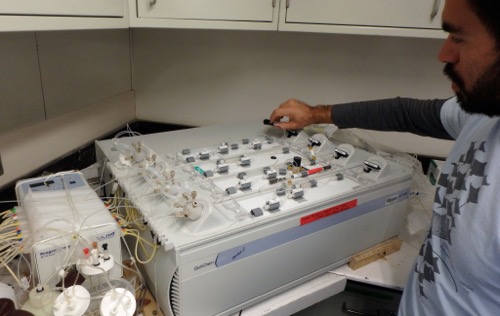
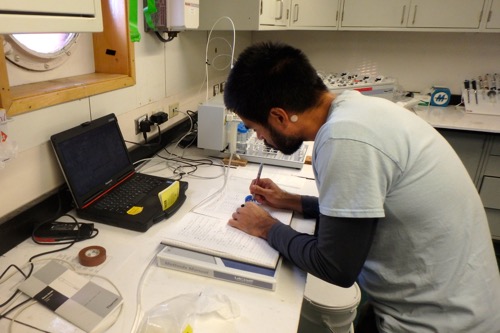
The FIA works by pumping seawater samples past different reagents that will react with specific nutrients. These chemical reactions will allow the computer to analyze the samples and determine the concentrations of the desired nutrients. For the purposes of this cruise, the desired nutrients include nitrate, nitrite, ammonium, silicate and phosphate.
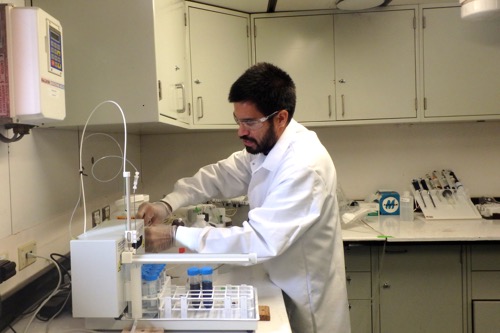
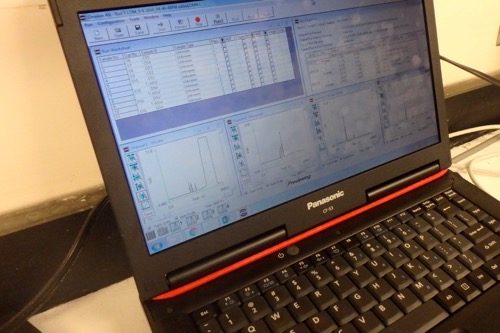
Will begins sampling water as soon as possible in order to monitor the conditions of the water as we travel through the Drake passage. In talking with Will and Dr. Kristen Buck of USF, I also learned that Will's data will help determine when we have reached a specific area of the Southern Ocean where specific types of diatoms are likely to be found. DiatomsDiatoms are one of the most common types of phytoplankton. Most diatoms are unicellular, although they can exist as colonies in the shape of filaments or ribbons. Diatom communities are a popular tool for monitoring environmental conditions, past and present, and are commonly used in studies of water quality. have a outer "shell" called a silica frustule. As the name implies, these frustules are essentially made using the silica from the ocean water to build this outer "shell", similar to a cell wall in plants. Finding the areas of high silicate allow Dr. Buck and the other scientists to decide where to sample in the hopes of collecting specific types of phytoplankton.
Troubleshooting
Will spent most of the day prepping the FIA machine, remixing some reagents and sampling water from the flow-through system. I was given the opportunity to put on some goggles, gloves and a lab coat and act as assistant for the day. I collected water every 30 minutes and helped Will trouble shoot a problem with the FIA. Ok - I watched while Will did the troubleshooting, but he said he enjoyed the company.
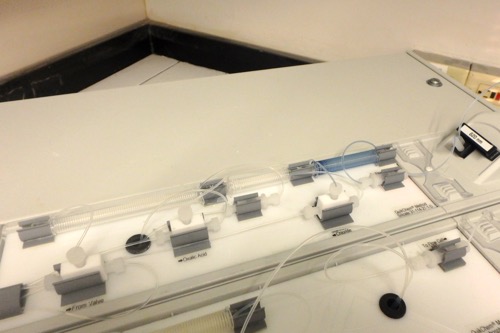
While Will continued to work on the FIA nutrient sampling, I stepped outside to help with the first trace metal CTDA research tool that is submerged in the water to measure conductivity (salinity), temperature, and depth. cast and conventional CTDA research tool that is submerged in the water to measure conductivity (salinity), temperature, and depth. cast of the cruise. Wondering how they are different? I will tell you all about this 'shakedown' sampling in tomorrow's post. For now, please enjoy the first of what I hope is many wildlife sighting updates.
First Wildlife Sighting
During my time on the bridge this morning, I saw a Cape Petrel (Daption capense). This marks my first wildlife sighting in the Drake PassageStrait, connecting the Atlantic and Pacific oceans between Tierra del Fuego and the South Shetland Islands. Located about 100 mi (160 km) north of the Antarctic Peninsula, it is 600 mi (1,000 km) wide.. According to James Lowen in his Antarctic Wildlife: A Visitor's Guide (2011), these small petrels have a length of 14-16 inches (35-41cm) and a wingspan of 31-36 inches (81-91cm). These petrels have a beautiful dark brown-and-white pattern on their backs and upper wings in addition to a white rump patch with dark spots. I have seen another type of petrel during my time in the waters off the coast of New England. This species is known as the Wilson's Storm Petrel and differs in size (generally smaller) and usually have an all dark coloration except for a white rump patch.

Petrels are known to spend most of their lives at sea, only coming ashore for a short nesting period. Petrels have tube-shaped nostrils that vary in size with each species. These tubes help to drain the excess salt secreted from a duct near the bird's eye. The ability to remove excess salt allows these birds to spend longer times in saltwater without returning to land for drink freshwater. It was difficult to get a good picture of the Cape Petrel with the rough seas and ocean spray, but you can see more pictures on the Encyclopedia of Life website.


Comments